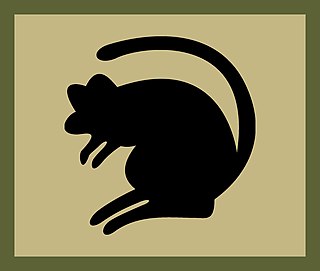
The 1st Division is an active division of the British Army that has been formed and disestablished numerous times between 1809 and the present. In its original incarnation as the 1st Division, it took part in the Peninsular War—part of the Coalition Wars of the Napoleonic Wars—and was disbanded in 1814 but was re-formed the following year for service in the War of the Seventh Coalition and fought at the Battle of Waterloo. It remained active as part of the British occupation of France until it was disbanded in 1818, when the British military withdrew. The division was then raised as needed; it served in the Crimean War, the Anglo-Zulu War, and the Second Boer War. In 1902, the British Army formed several permanent divisions, which included the 1st Division, which fought in the First World War, made various deployments during the interwar period, and took part in the Second World War when it was known as the 1st Infantry Division.

Amarah, also spelled Amara, is a city in south-eastern Iraq, located on a low ridge next to the Tigris River waterway south of Baghdad about 50 km from the border with Iran. It lies at the northern tip of the marshlands between the Tigris and Euphrates.

The Iraqi Ground Forces, also referred to as the Iraqi Army, is the ground force component of the Iraqi Armed Forces. It was formerly known as the Royal Iraqi Army up until the coup of July 1958. The current commander is Lieutenant General Qassim Muhammad Salih.

The 7th Armoured Brigade was an armoured brigade formation of the British Army. The brigade is also known as the "Desert Rats", a nickname formerly held by the 7th Armoured Division, of which the brigade formed a part during the Second World War until late 1941.

16 Air Assault Brigade Combat Team, known simply as 16 Air Assault Brigade from 1999 – 2021, is a formation of the British Army predominantly based in Colchester, Essex. It makes up the Air Assault Task Force, a battlegroup held at high readiness, and is the only brigade in the British Army focused on operating via parachute, helicopter and air-landing.

The Battle of Norfolk was a tank battle fought on February 27, 1991, during the Persian Gulf War, between armored forces of the United States and United Kingdom, and those of the Iraqi Republican Guard in the Muthanna Province of southern Iraq. The primary participants were the U.S. 2nd Armored Division (Forward), 1st Infantry Division (Mechanized), and the Iraqi 18th Mechanized and 9th Armoured Brigades of the Republican Guard Tawakalna Mechanized Infantry Division along with elements from eleven other Iraqi divisions. The 2nd Armored Division (Forward) was assigned to the American 1st Infantry Division as its 3rd maneuver brigade due to the fact that one of its brigades was not deployed. The 2nd Armored Division (Forward)'s Task Force 1-41 Infantry would be the spearhead of VII Corps. The British 1st Armoured division was responsible for protecting the right flank of VII Corps, their main adversary being the Iraqi 52nd Armored Division and multiple infantry divisions. It was the final battle of the war before the unilateral ceasefire took effect.

The 8th Mountain Division is a division of the present-day Indian Army that specialises in mountain warfare.

4th Light Brigade, provides light infantry mass, offering significant utility in operate tasks and with the ability to surge ground manoeuvre units by air or sea to reinforce UK forces or partners.Previously known as 4th Infantry Brigade and Headquarters North East, and before that as 4th Mechanized Brigade and before that 4th Armoured Brigade is a brigade formation of the British Army, currently based in Catterick, North Yorkshire as part of 1st Division. The brigade, now known as the 'Black Rats', was formed in 1939 and fought in the Second World War, in the Western Desert Campaign and in North Africa. The Black Rats were subsequently involved in the invasion of Sicily and fighting in Italy before taking part in the Battle of Normandy and the advance through Belgium, Holland and into Germany.

The 20th Armoured Brigade Combat Team, previously the 20th Armoured Infantry Brigade, is an armoured infantry brigade formation of the British Army, currently headquartered at Wing Barracks, Bulford, Wiltshire, as part of the 3rd Division.
Multi-National Division (South-East) was a British commanded military division responsible for security in the south east of Iraq from 2003 to 2009. It was responsible for the large city of Basra and its headquarters were located at Basra Airport. The division was initially responsible for the governorates of Al Muthanna, Maysan, Basra, and Dhi Qar. MND-SE was a subordinate division of Multi-National Corps Iraq. Multi-National Corps Iraq was itself part of Multi-National Force-Iraq.
Operation Before the Dawn was an offensive operation launched by Iran during the Iran-Iraq War in 1983 around the Amarah area 200 kilometers southeast of Baghdad. It was carried out under the command of the Islamic Revolutionary Guard Corps along with the support of the regular army, during the operation, Iran suffered heavy casualties due to weak air support and heavy Iraqi artillery fire and aerial bombing.
Iraqforce was a British and Commonwealth formation that came together in the Kingdom of Iraq. The formation fought in the Middle East during World War II.
These are the orders of battle of the Iraqi and Iranian armies for the start of the Iran–Iraq War in 1980. The data is drawn from the Air Combat Information Group's Arabian Peninsula and Persian Gulf Database.

The 1st Division (IFF) is a motorized infantry division of the Iraqi Army headquartered in Camp Fallujah.

The 9th Armoured Division is a formation of the Iraqi Army, originally formed probably around 1975, but disbanded in 1982. It was reformed after 2004.

The 5th Division is a military formation of the Iraqi Army. The division is currently deployed in eastern Iraq – predominantly Diyala Governorate. Following the losses suffered by the Iraqi Army during fighting in the ISIL campaign in Northern Iraq, the Iraqi security forces became increasingly reliant on non-state militia units – the Popular Mobilization Forces. As of October 2015, Reuters reported that the 5th Division reported to the PMF chain of command, instead of the official military hierarchy.

The 17th Division is a division of the Iraqi Army, active before and after 2003.
The 2nd Corps was a corps of the Iraqi Army, established before the Iran-Iraq War. It was initially located in the central regions of Iraq.
The Ninewa Operational Command (NOC) is a interagency command of the Iraqi Armed Forces and Iraqi Ministry of the Interior. Up until 2014 it had its headquarters in Mosul. It holds responsibility for all anti-ISIS operations in Ninewa Governorate.
The Basra Operations Command is an organisation of the Government of Iraq which coordinates both Ministry of Defence and Ministry of Interior security forces in Basra Governorate. It was established in August 2007, and quickly became involved in the Battle of Basra (2008) against the Shia Jaysh al-Mahdī militia in Basra.The BOC is headquarted in Basrah.











